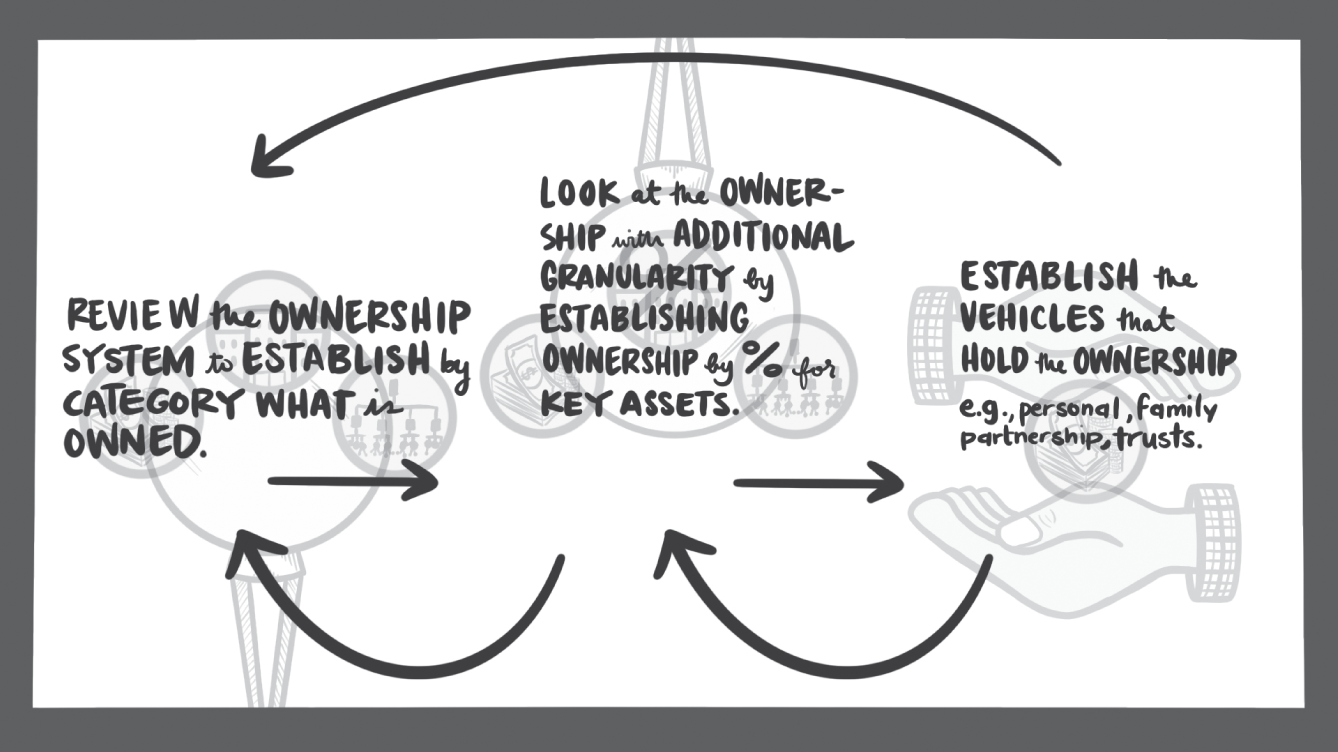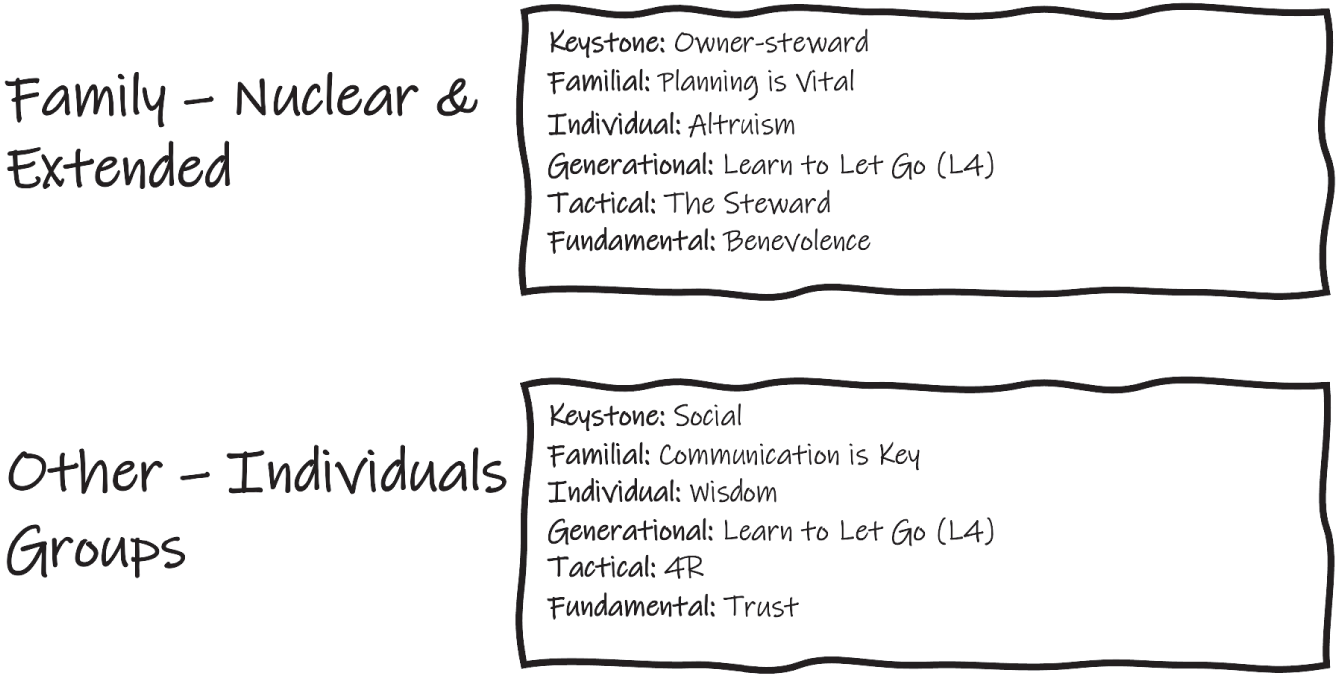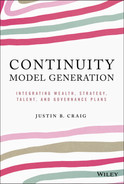Wealth: Asset, Wealth, and Estate Planning for Continuity
Cornerstone Concept: Produce a Handwritten Individual Legacy Statement
Preamble: Continuing in the best financial shape is the holy grail for family business. Everyone knows that. But many postpone doing anything about it…until it is too late. Much of continuity hinges on this plan, arguably the most important of the four plans here.
This plan aims to reduce potential for tension between the owners and the broader family. Of the four plans, this is the most sensitive and the most technical. It is also the one most likely to be shrouded in secrecy. Conspiracy theories abound. Moreover, it is also the one most commonly avoided. Yet the image of the crusty old patriarch dying at his desk and ruling from the grave is not consistent with continuity modeling. The Continuity Generation has a more pragmatic perspective. They recognize that strong financial health and familial harmony significantly enhance chances for continuity. So, rather than avoid asset, wealth, and estate (AWE) planning, they tackle this head-on. In general, the Continuity Generation believes that dealing with difficult, sensitive conversations openly addresses much of the inevitable tension in family business. “There is another way” is the Continuity Model Generation mantra.
Asset, Wealth and Estate Planning for Continuity I: Collecting and Collating Basic Information
What will likely become obvious in these pages is that building your Continuity Canvas takes some patience and a degree of detective work. It may also require difficult conversations previously considered off-limits. Two hints here: (i) tread lightly, and (ii) be prepared to back off and move on from this plan to one of the others if you find that some simply aren't ready for it. But focusing elsewhere does not mean you have given up at the first sign of resistance. It simply suggests that the aim is to build momentum around continuity (and its close relation, legacy, which is a much easier pill to swallow than “succession,” for even the staunchest naysayer).
Proceed by looking at the ownership system. It is often surprising, to even the most seasoned experts, how few owners in multi-generational, business-owning families have intimate knowledge about what they actually own. This is not such a big deal with earlier-stage entities, of course. But the situation changes as businesses and families grow, particularly when there is a liquidity event or a generational change in ownership. Here it is important not to fall into the trap of personality and/or family faction judgment. Remember, the aim is continuity. Sometimes it is best to avoid the trap by staying focused on “technical” issues, and to examine ownership structures and entities, rather than individuals as owners. Avoid potential minefields. The more complex the business activities and the older the family (in generational terms), the more difficult and challenging this undertaking. But that is not an excuse, when the aim is to understand to continue by continuing to understand. So, acknowledge the complexity but aim to keep it as simple as possible. Recall the analogy of ensuring a ten-year-old can follow the gist. Perhaps create an evidence chart, as if you were a detective solving a case. That way there will be a trail.
Start with the understanding that each entity is 100%-owned by someone and work out who owns what portions of that 100%. Do not focus on what that holding is worth. That really does not matter to this conversation. Moreover, be warned that complex trust structures will send you down rabbit holes. Avoid them where possible. In some cases, such trusts may be a delaying tactic by someone not drinking the continuity Kool-Aid™ or inherited and in place for taxation minimization (not avoidance). Regardless, now is not the time to be unraveling these. Instead, flag the need for a future, healthy discussion about whether these structures are contributing or limiting continuity chances. It could be that the trusts must be dissolved and reformulated, in the name of continuity modeling.
The second activity required to build a Continuity Canvas in the AWE planning process, just as was advised in the Strategic Plan, is to honestly evaluate each owner's preparedness to transition their estate, wealth, and assets (Illustration 28). This scrutiny is difficult but necessary. It really is the “day after you bury or burn me” test, morbid as that may be. It involves owners holding a mirror up to themselves and asking how healthy their assets, wealth, and estate are in terms of contributing to or harming the chances of continuity. A generation ago, this was unthinkable. But the Continuity Generation expects, even demands, to know what cards they are going to end up holding. The incumbent generation should know the cards. After all, they are holding them. To not engage is unfair…for all stakeholders. Always has been, always will be.
Message to incumbents: set the next generation(s) up for success; don't make it more difficult than it already is. Okay, I'll step off my soapbox now.
There is no one way to go about this step of AWE planning. It is vital that you (i) uncover the evidence in percentage ownership terms rather than dollar figures, and (ii) honestly evaluate how well the wealth, assets, and estate are placed to be efficiently transferred in the future. Consider drafting a table on a whiteboard, and figure it out for yourselves. Likely, you'll eventually require involvement of trusted advisors, lawyers and accountants. But do not outsource the problem to them. It is not their problem. They love problems; indeed, that's their business model.

Illustration 28 THREE-STEP APPROACH PLAN FOR THE ASSET, WEALTH, AND ESTATE PLAN
Tread lightly but do tread into the territories this planning requires.
Asset, Wealth, and Estate Planning for Continuity II: Cornerstone Concept Equals Produce a Handwritten Individual Legacy Statement
As for the previous plans discussed, with some basic descriptive information in hand, the platform is set for the second stage, or the application of selected frameworks to understand more fully what is required to develop an AWE planning process for continuity. The cornerstone objective here is to produce a handwritten individual legacy statement. There are three aspects of this: (i) handwritten, (ii) individual, and (iii) legacy. To clarify, this is not intended to be a legally binding document. It is the opposite. The statement may influence a legal document eventually, but in no way is it intended to replace a will, a trust deed, a whatever. It is the antecedent to many of these documents. It is what it is…a hand-written individual legacy statement. More specifically, it articulates one's very personal intentions to be remembered and how any assets, wealth, or estate items can best be deployed or redeployed to raise chances for the business and the family to continue as major contributors to commerce and society. This idea must be stressed and restressed. The ultimate handwritten document, further, contains sentiments typical of a eulogy. Indeed, if it feels more comfortable and helps keep the legal team at bay, call the statement the opening paragraph to your eulogy!
Keeping true to our central model, the overarching objective is to develop an asset, wealth, and estate planning process for continuity that is driven by the 21 frameworks. For this plan, we are concerned with how the frameworks apply to four groups: (i) family–nuclear, (ii) family–extended, (iii) other–individuals, and (iv) other–groups (Illustrated Table 3). Given the personal nature of this activity, it is easier to group the groups and consider more broadly the application of the frameworks. But the intent is to motivate broader and deeper thought processes. It is inevitable that everyone must do this eventually. Doing it as part of the Continuity Model Generation process is far preferred to being dragged into a lawyer's office and asked questions for which you are likely not prepared.
Stay in the helicopter. The view (and viewpoint) is better. Avoid getting distracted. Look more through the windshield than at the rear-view mirror. Keep reminding yourself that what you produce is not legally binding; that will come later. It is a commitment to the understanding that having a plan will significantly reduce tension and the potential for conflict between owner-stewards and the increasingly diverse family of families. If it feels uncomfortable, that is normal and not a bad thing. In fact, embrace the process as being as, or more, important than anything you have done in your career and family life. Keep asking yourself if you are asking the right questions. It doesn't matter what others think if you start to say this aloud. “Am I asking the right questions” is a useful safe harbor to retreat to when you are overwhelmed, no matter the context. You will never get perfect information but knowing that is part of the process of developing a tolerance of ambiguity, which is a prerequisite for continuity thinking. To think and act broadly and deeply about this topic, and plan, really is, as someone once put it, the final test of greatness.

Illustrated Table 3 POPULATING THE ASSET, WEALTH, AND ESTATE CATEGORIES USING THE FRAMEWORKS
Keystone Meta-Framework
I: Owner–Steward: The systems in the three circles framework are not static. Each is in flux. For example, the commercial activities that the manager–stewards manage for the owners are evolving, constantly. The portfolio of assets, the businesses, and the investments change. The overall equity value changes, hopefully positively. Expected returns are at the mercy of many extraneous factors. Some assets are divested. Debts and other borrowings also change. This all has an impact to be acknowledged and monitored.
The owner–steward has a responsibility to carefully consider the implications of their asset, wealth, and estate planning intentions. Having continuity as the dominant consideration focuses the owner–steward and informs those influencing their decision-making process.
Dividing beneficiaries, as suggested here, is a non-threatening way for an owner to fulfill their various obligations. It enables them a safe place to begin discussions. One approach is to think of the task in strategic terms as the shared objective. For example, the objective is to ensure that the transfer of wealth enhances family legacy through prudent distribution to family (close and extended), as well as to individuals and groups who have meaningfully impacted your life. This itself could be the start of your handwritten legacy statement.
II: Social: Throughout this book we have discussed the complementary foci of business-owning families. When cascading this to individual AWE planning, it makes sense to acknowledge the social imperatives supported by the business as a collective stakeholder when considering beneficiaries. This can be captured in the other-group category, which also includes individual “pet” projects.
Familial Meta-Framework
I: Planning is Vital: The saying that someone will “die with their boots on and rule from the grave” becomes especially pertinent for AWE planning. The reasons to plan are many, and there's no need for us to list them here. One senior family business owner who had long put off planning his AWE finally found motivation when a confidante suggested that if he did not act, the lawyers would get the majority of his estate. There is an expectation from the next-generation that their now-generation commit to approaching this process sensibly…by planning.
A revisit to the three circles’ diagram you drew in the opening sections will highlight two major drivers of the need for planning. One is that the owner–stewards are a heterogenous group. Recall the economic versus psychological utility we plotted on a continuum. The second is that the family of families becomes larger, more diverse, and more complicated for multiple reasons.
II: Communication is Key: Those who get it right communicate, communicate, communicate. While many have mastered the art of difficult business conversations over their careers, having difficult personal or family conversations has not typically been a strong suit. Avoiding communicating will not make the problem go away. Though most recognize that truth, they still struggle with it.
When the topic came up in one family, the third-generation successor who had been anointed to lead the business and his generation, asked the second-generation owners – his father, mother, uncle, and aunt – a simple question: “Can you go away and work out how much you need?” The second-generation sibling partners had reinvested in the business over their working lives. Their reinvestment had two outcomes. One was that the business had grown considerably, was financially and strategically healthy, and debt-free. The second was that they did not have sufficient retirement funds to live comfortably for the following decades. Thus, the successor and his cousin consortium needed this information about their parents’ personal needs so they could develop the financial plan to continue the growth, and the legacy, while providing sufficiently for the previous generation.
In another example, a founder wanted to ensure that his second wife was cared for after his passing. But he quickly found that this was not an easy conversation to have with his children, due to some unresolved tension about the second marriage. This is not an unusual occurrence, with ever more “hybrid” families populating the family–steward circle.
The good news is that there are plenty of trusted advisors to facilitate these conversations. That is what they do. Communicate with them early and often. Do not wait for them to have the conversation with you: shock them by bringing it up. That's what a continuity modeler would do. This conversation also needs to happen at the board level…with all boards. The discussion falls under the category of “risk,” because that is what it is. Put it on the agenda. Lead the conversation.
And yes, the topic of pre-nuptials needs to figure into these conversations. Don't avoid that.
Individual Meta-Framework
I: Altruism: Altruism, one of the five servant leadership framework dimensions we discussed, is about a leader's deep-rooted desire to make a positive difference in others’ lives. So, in the spirit of encouraging a broadened, deeper interpretation of the dimensions and frameworks, the message related to altruism in the context of AWE planning could be that careful, meaningful AWE planning ensures altruism does not die with the individual. Follow that train of thought and see where it leads. Optimizing these sentiments requires, among other things, wisdom as discussed below.
II: Wisdom: Wisdom in the servant leadership framework, as previously noted, is a combination of awareness of surroundings and anticipation of consequences. When these two characteristics are combined in an individual, the person becomes adept at picking up cues from the environment and understanding their implications. Awareness and consequences are about perspicacity (think L3 of the four Ls), whereby perspicacious individuals have insight into their family, their business, and themselves. Considering thoughtfully the consequences of any AWE plan requires the wisdom that proponents of servant leadership refer to. Consider broadening and deepening that to AWE when crafting a legacy statement.
Generational Meta-Framework
I: Learn to Let Go: The robustness of the four Ls framework has been on display throughout these pages. It has been suggested that L4, letting go, is the most difficult. To emphasize that, I share here an important excerpt from Moores and Barrett of the original study that generated this framework:
II: Learn to Let Go: Reread the previous section. (Then consider reading it again.)
Tactical Meta-Framework
I: The Steward: A steward is someone who identifies with the organization; they see themselves as an intimate part of the business and, therefore, shoulder responsibility for the organization's success. As a result, a steward will feel satisfaction about the firm's successes and disappointment from its failings, and will work hard to overcome organizational obstacles, aligning their own interest with those of the principals. These stewards, moreover, are motivated not by personal recognition or gain; they benefit only when the organization does. Applying this to the AWE planning process would mean that the consequences of any decisions related to the transfer of assets and wealth will be framed around benefiting the organization, or others. This is legacy, and the linchpin of continuity.
II: Four Rs–Role: The owner role entails specific requirements and responsibilities. When you populate the four Rs matrix, remember that this role encompasses careful deliberation about how assets, wealth, and estates will be transferred across generations. That would be the kind of broader, deeper thinking required of the Continuity Generation.
Fundamental Meta-Framework
I: Benevolence: Benevolence denotes a desire to do good. Thus, it is critical to establishing a personal legacy statement. No need to invent new words for this; use the ones gifted by the frameworks.
II: Trust: The four trust dimensions framework provided a simple but effective rubric for how trust manifests in relationships. Extending that to the AWE planning conversation, a broader and deeper perspective yields the opportunity to examine different types of trust. This would reveal that the highest degree of trust is identification-based trust, where a collective identity between the trustor and the trustee is so strong that “each party can represent the other's interests with their full confidence” (Dietz and Den Hartog 2006, p. 564; Lewicki and Bunker 1996). For identification-based trust to evolve, the parties must rely on extensive knowledge about one another's behaviors, needs, and preferences, effectively becoming a shared identity (Lewicki and Bunker 1995; Lewicki and Bunker 1996). It is this level of trust that would be expected to evolve between those transferring their AWE and their beneficiaries.
